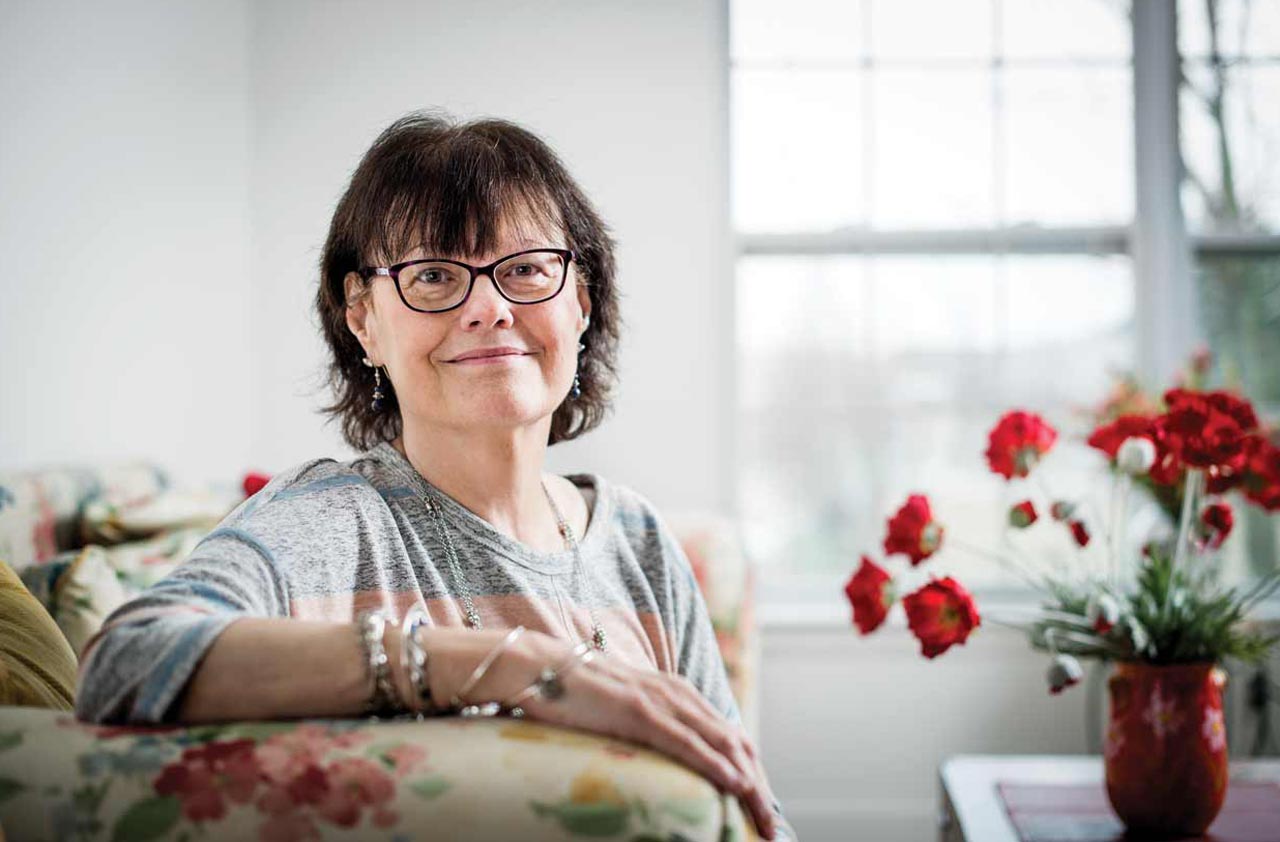Living With Cancer
For millions of people, cancer is neither a death sentence nor an impediment to a long, fulfilling life.

President Richard Nixon declared war on cancer in 1971, but 46 years later, a single cure remains elusive. That doesn’t mean significant progress hasn’t been made. New treatments and technologies have enabled people with even advanced cancers to live for years after their initial diagnosis. There are 15.5 million cancer survivors in the U.S., and two-thirds of them were diagnosed more than five years ago. Nearly 45% have lived for 10 years or more after their diagnosis.
SPECIAL REPORT: Fighting Cancer
In 2009, Whitney Archer, 33, of Gainesville, Va., was diagnosed with a cancerous brain tumor known as an astrocytoma. Doctors were able to remove only 40% of the tumor, but Archer has gone on to lead a normal life, with no seizures or headaches since her surgery. She works as a librarian and part-time editor; looks after her son, Nate; and crochets and makes strawberry jam. Every three or four months, she and her husband, Daniel, battle Washington-area rush-hour traffic to go to the National Institutes of Health in Bethesda, Md., where she has an MRI. So far, all of the scans have been good. If her cancer reawakens, she says, she’s willing to try whatever treatments her doctors recommend.
Archer says she struggles with how to respond when people ask if her cancer has been cured. “Most of the time I just say, ‘It’s complicated.’ ”
From just $107.88 $24.99 for Kiplinger Personal Finance
Become a smarter, better informed investor. Subscribe from just $107.88 $24.99, plus get up to 4 Special Issues

Sign up for Kiplinger’s Free Newsletters
Profit and prosper with the best of expert advice on investing, taxes, retirement, personal finance and more - straight to your e-mail.
Profit and prosper with the best of expert advice - straight to your e-mail.
Hitting the bull’s-eye
Researchers have learned that the war on cancer must be fought on many fronts. The most promising developments are in targeted therapies, which use drugs or other substances to interfere with specific molecules involved in the growth and progression of cancer. The first breakthrough in this type of therapy came in 2001, when the chemotherapy drug Gleevec was approved to treat chronic myelogenous leukemia (CML), a blood cancer usually caused by a gene flaw that develops during an individual’s life.
Gleevec blocks the gene’s activity, transforming the disease from a fatal condition into a chronic one. New research indicates that the drug works so well in eliminating the cells with the rogue gene that patients may be able to stop taking it after a few years. If the disease returns, the patient’s immune system may be able to keep the disease under control.
A newer type of targeted therapy with huge promise is immunotherapy. Its potential to harness the body’s own immune system to destroy cancer cells has captured the imagination of researchers, says Dr. Elad Sharon, a medical officer with the National Cancer Institute. In some cases, drugs are used to “take the brakes off” a patient’s immune system, revving it up so that it will attack cancerous cells. In other therapies, laboratory-produced antibodies are used to attack a specific part of a cancer cell.
Immunotherapy drugs have received accelerated approval to treat head and neck cancers, non-small-cell lung cancer, Hodgkin’s lymphoma, and melanoma, among other cancers. Former President Jimmy Carter used Keytruda, an immunotherapy drug, to treat advanced melanoma that had spread to his liver and brain. In 2015, Carter announced that he was cancer-free. (For the investment prospects of companies producing immunotherapy and other cutting-edge cancer treatments, see 5 Best Stocks for Investing in Cancer Treatments.)

Other types of targeted therapies are helping patients with cancers that don’t respond to immunotherapy. Deb Ragosta, 62, of Plainville, Mass., has been treated with anti-estrogen and other targeted-therapy drugs since 2009, when she was diagnosed with stage IV breast cancer, the most severe form of the disease. Ragosta was first diagnosed with early-stage breast cancer in 1990. She found out years later that her cancer had reoccurred after she hurt her back on a trampoline. Her x-rays revealed a suspicious lesion on her spine, and further tests revealed that her breast cancer had metastasized to several spots on her back and one on her skull. Ragosta says she was floored by the news. Overnight, she went from someone who thought she was cured to a woman who will probably live with breast cancer for the rest of her life. “Had I not gone on the trampoline, I wouldn’t have been diagnosed because I had no symptoms,” she says.
But Ragosta’s treatments, through the Dana-Farber/Brigham and Women’s Cancer Center in Milford, Mass., have kept her cancer from progressing. She babysits for her two grandchildren a couple of days a week, teaches defensive driving and writes a blog, Don’t Stop Believing, for women with breast cancer. Convinced that writing is a good form of therapy, she provides writing classes for cancer survivors at Dana-Farber.
Ragosta tries to stay informed about new treatments. She recently applied to participate in a clinical trial but was told she was too healthy to qualify.
Qualifying for a clinical trial
Many people believe that clinical trials are only for cancer patients who have exhausted all other options. Others fear they’ll receive a placebo instead of a potentially life-saving drug.
In reality, clinical trials are available for all stages of cancer. Placebos are rarely used for cancer patients. Instead, the control group typically receives the “standard of care”—the treatment for the disease that has already been approved. Some will receive the standard of care along with the experimental drug. If results show that the trial drug is much more effective than the standard treatment, trial sponsors are required to switch all participants to the new drug, says Mandi Battaglia Seiler, a patient-services team supervisor for the American Cancer Society.
Even so, some cancer patients are rejected from clinical trials, either because they’re too healthy (like Deb Ragosta) or because they’re too ill. Tom Marsilje, 45, was diagnosed with colon cancer in 2012; in 2014, he learned that it had spread to his lungs and lymph nodes. But chemotherapy kept his cancer from spreading until recently, when tests showed tumors in his liver. That forced him to postpone participating in a clinical trial for immunotherapy.
Marsilje, an oncology researcher, hasn’t been sidelined by his diagnosis. Rather, he has devoted himself to raising awareness about colorectal cancer research and clinical trials. He provides updates on research and clinical trials through Colontown, a private Facebook community for people with colorectal cancer and their families. He answers questions about immunotherapy at TheAnswertoCancer.org, a website founded by the Cancer Research Institute, an immunotherapy advocacy group.
Meanwhile, Marsilje is pursuing an aggressive course of treatment for the tumors in his liver, and he remains optimistic that he’ll be able to keep his cancer in check. Ten years ago, he notes, advanced melanoma was considered a death sentence. Now people are living with that diagnosis for years. “I never give up hope,” he says.
If you’re interested in joining a clinical trial, start by talking to your doctor, who may be aware of trials that are appropriate for your situation. You can also research trials on your own, but you’ll need to do some legwork. To determine your eligibility for a trial (or trials), you need to be able to provide the details about your cancer diagnosis. The National Cancer Institute, a division of the National Institutes of Health, provides a checklist; to find it, go to www.cancer.gov and search “how to join a clinical trial.”
In most cases, the sponsor of the trial will cover the cost of the new treatment, along with special tests, procedures and doctor visits. Some also pay travel costs, but that’s not always the case, so find out what your expenses will be before you agree to participate. Study sponsors may be willing to pick up costs that aren’t covered by your insurance.
Because there’s a shortage of participants, clinical-trial sponsors “trip all over themselves” to take care of people who enroll, Seiler says. “You’re as valuable to them as they are to you.”
Updating old treatments
In many cases, physicians must still rely on traditional treatments, such as radiation and chemotherapy, to treat cancer. But researchers have found ways to use them more effectively.
For example, proton beam therapy, which uses the positively charged particles in an atom, delivers high doses of radiation to tumors without damaging surrounding tissue (see How to Cover the Cost of Cancer Care). It’s particularly effective in treating tumors that are located near critical organs, such as the brain, esophagus, liver and lungs. Dr. Kathryn Ruddy, an oncologist at the Mayo Clinic who specializes in breast cancer, says many of the clinic’s breast-cancer patients are opting for proton beam radiation because it’s less toxic than traditional radiation. There’s also a lower risk that the radiation will cause a secondary cancer, she says.
Meanwhile, years of experience with chemotherapy drugs have enabled doctors to deliver doses that are more precise and less toxic, Ruddy says. And anti-nausea medications have made it much easier for patients to tolerate chemotherapy, she says. Chemotherapy is also being used in combination with new treatments, such as immunotherapy.
Improved technology plays a big role, too. Doctors can more easily detect a reoccurrence of cancer at an early stage, which improves patients’ odds of survival. Catherine Goff, 62, of Dover, Mass., was diagnosed with Hodgkin’s lymphoma when she was 21. Aggressive radiation treatments cured the lymphoma, but the high doses of radiation—much higher than those that would be used today—left her at risk for a secondary cancer. Goff did develop secondary breast cancer at age 55, but because she participated in regular screenings, her doctors were able to detect the cancer at an early stage. In December 2009, she had a double mastectomy.
Goff says it’s much easier to talk about cancer now than it was when she was first diagnosed more than 40 years ago. “When I was 21, you didn’t even say the C word,” she says. “Now you’re encouraged to talk about it.”
That’s in part thanks to the willingness of Jimmy Carter and other public figures to talk about their own experiences, says Julia Rowland, director of the Office of Cancer Survivorship at the National Cancer Institute. “A lot more people realize there’s life after cancer.”
Information you can trust
The internet provides an abundance of information about every stage and category of cancer, but spending hours consulting Dr. Google could be bad for your health. Some websites provide information that’s confusing, contradictory or flat-out wrong.
-- One source of reliable information is the National Cancer Institute. In addition to updates on everything from prevention to clinical trials, the NCI offers a help line (800-422-6237) with information specialists who are able to answer questions about cancer and provide details about programs offered by the NCI.
-- The American Cancer Society is another good source of general information that also offers a help line (www.cancer.org; 800-227-2345). The ACS provides a matching service for patients interested in clinical trials. You can find a list of trials within your zip code on its TrialCheck database. To speak with a clinical trials specialist, call 800-303-5691. You can find more information at www.learnaboutclinicaltrials.org.
-- The National Library of Medicine provides a detailed list of clinical trials for cancer and other diseases at www.clinicaltrials.gov. It currently lists more than 230,000 trials in the U.S. and around the world. Note, however, that the listing is not particularly user-friendly.
-- Support groups can provide encouragement, advice and up-to-date information, and there’s one for every type of cancer. Your local hospital or a social worker can help you find one; you can also do an online search. Cancer support groups can also provide information about clinical trials.
The cancer moonshot
In his 2016 State of the Union address, former President Barack Obama announced that Vice President Joe Biden would lead a national initiative, Cancer Moonshot, to “end cancer as we know it.” The program was created in honor of Biden’s son Beau, who died of brain cancer in 2015.
The project’s research efforts include using crowdsourcing to map and identify cancer technologies so that funding can be directed to the most promising treatments. The National Institutes of Health and the Food and Drug Administration have announced a series of programs to improve clinical trials and make them easier for patients to locate. Other Moonshot programs run the gamut from ride-sharing for low-income patients to free mammograms for women who don’t have health insurance.
The program could be sharply curtailed by President Trump’s proposed budget, which calls for a 19% reduction in funding for the National Institutes of Health. However, those cuts are expected to face tough opposition in Congress.
Profit and prosper with the best of Kiplinger's advice on investing, taxes, retirement, personal finance and much more. Delivered daily. Enter your email in the box and click Sign Me Up.

Block joined Kiplinger in June 2012 from USA Today, where she was a reporter and personal finance columnist for more than 15 years. Prior to that, she worked for the Akron Beacon-Journal and Dow Jones Newswires. In 1993, she was a Knight-Bagehot fellow in economics and business journalism at the Columbia University Graduate School of Journalism. She has a BA in communications from Bethany College in Bethany, W.Va.
-
 Changes Are Coming for This Invesco Bond Fund
Changes Are Coming for This Invesco Bond FundThe Invesco BulletShares 2026 Corporate Bond ETF's bonds will mature in 2026. Here's what investors should do.
-
 What Science Reveals About Money and a Happy Retirement
What Science Reveals About Money and a Happy RetirementWhether you’re still planning or already retired, these research-based insights point the way to your best post-work life.
-
 7 Retirement Planning Trends: What They Mean for You in 2026
7 Retirement Planning Trends: What They Mean for You in 2026From government shutdowns to market swings, the past 12 months have been nothing if not eventful. The key trends can help you improve your own financial plan.
-
 9 Types of Insurance You Probably Don't Need
9 Types of Insurance You Probably Don't NeedFinancial Planning If you're paying for these types of insurance, you may be wasting your money. Here's what you need to know.
-
 Amazon Resale: Where Amazon Prime Returns Become Your Online Bargains
Amazon Resale: Where Amazon Prime Returns Become Your Online BargainsFeature Amazon Resale products may have some imperfections, but that often leads to wildly discounted prices.
-
 Roth IRA Contribution Limits for 2026
Roth IRA Contribution Limits for 2026Roth IRAs Roth IRAs allow you to save for retirement with after-tax dollars while you're working, and then withdraw those contributions and earnings tax-free when you retire. Here's a look at 2026 limits and income-based phaseouts.
-
 Four Tips for Renting Out Your Home on Airbnb
Four Tips for Renting Out Your Home on Airbnbreal estate Here's what you should know before listing your home on Airbnb.
-
 Five Ways to a Cheap Last-Minute Vacation
Five Ways to a Cheap Last-Minute VacationTravel It is possible to pull off a cheap last-minute vacation. Here are some tips to make it happen.
-
 How Much Life Insurance Do You Need?
How Much Life Insurance Do You Need?insurance When assessing how much life insurance you need, take a systematic approach instead of relying on rules of thumb.
-
 When Does Amazon Prime Day End in October? Everything We Know, Plus the Best Deals on Samsonite, Samsung and More
When Does Amazon Prime Day End in October? Everything We Know, Plus the Best Deals on Samsonite, Samsung and MoreAmazon Prime The Amazon Prime Big Deal Days sale ends soon. Here are the key details you need to know, plus some of our favorite deals members can shop before it's over.
-
 How to Shop for Life Insurance in 3 Easy Steps
How to Shop for Life Insurance in 3 Easy Stepsinsurance Shopping for life insurance? You may be able to estimate how much you need online, but that's just the start of your search.